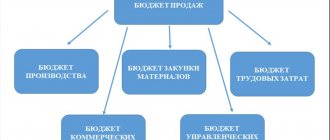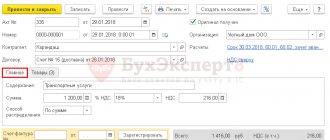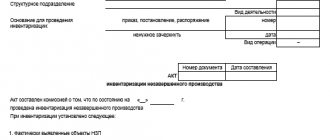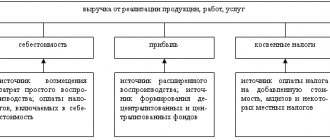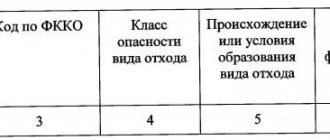In this article we will look at accounting for returnable production waste. Let's find out what is considered waste. Let's figure out how the types of waste differ. Let's talk about what documents are used to document waste in a warehouse.
Any company engaged in production inevitably generates waste of various types. Some of them are later put back into use, others are sold, and others are not to be used. In order to correctly process their capitalization, further use or sale, as well as not make mistakes in calculating taxes, an accountant needs to be armed with accurate knowledge. We will talk about what types of waste are, how they differ, what documents are processed and how they affect taxation.
What is waste?
Waste at a production enterprise can be things that have completely or partially lost their consumer properties.
These include:
- Residual raw materials;
- Own products;
- Semi-finished products;
- Materials;
- Inventory balances;
- Heat carriers.
They are divided into two groups:
- returnable waste;
- irrevocable.
Important! Returnable waste must be distinguished from all types of materials, distinguished from related products and other assets, since the correct calculation of cost, and, consequently, the tax base, depends on such differentiation.
What is returnable waste?
There is no definition of this concept in current regulations. The definition of the concept of “waste” is described in Federal Law No. 89 (dated July 20, 1998) “On production and consumption waste.” Waste refers to leftover materials and finished products whose original consumer properties have been lost.
The following types of waste are distinguished:
- Irrevocable - not processed to obtain recyclable materials.
- Returnable – suitable for re-use and resale.
The concept is further defined in accounting-related documents. In the Tax Code of the Russian Federation, waste refers to residual resources that are deprived of their original properties and qualities and are not suitable for use for their intended purpose.
Properties of returnable waste
The presented category of solid waste has its own characteristics. Due to this, they are assessed as an object of accounting and tax accounting.
Properties:
- Formed during production processes
- This is a material resource
- Actual properties differ from those of the raw materials
- After processing, they can bring income or other benefits
Classification of returnable waste
In enterprise management, it is customary to distinguish 2 categories of returnable balances.
These include:
- Used. Waste suitable for reuse in production for its intended purpose - participation in the main or auxiliary technological process.
- Unused. Resources consumed for purposes other than their intended purpose.
Recyclables do not include residues formed during irreversible reactions (volatilization, evaporation, drying). The described category of solid waste does not include waste used as feedstock in other production processes.
How are the types of waste different?
The separation of irretrievable and returnable waste is carried out according to their characteristics:
| Returnable waste | Irrevocable waste |
| Similarities | |
| Availability of material embodiment* Are a product of manufacturing processes Changed/lost properties in full or part of them | |
| Difference | |
| Bring income For future use: – in all types of production processes with increasing costs - for a purpose that does not correspond to the original one | Does not provide economic benefit Not used in this production, but: – suitable for the manufacture of other types of goods and products – possible release as related (by-product) products |
There is a type of waste classified as irrevocable, which does not have a material form, for example, such as: evaporation, volatilization, attrition, drying of materials.
Returnable waste in accounting
Industrial waste is generated as a result of processing raw materials into finished products. Residues from raw materials and materials that have completely or partially lost their properties are called waste. Waste can be irretrievable or returnable. The first of them cannot be reused by the enterprise due to technological features, and also cannot attract a buyer. They are disposed of and are not reflected in accounting.
Returnable waste (hereinafter referred to as RR), on the contrary, can either be used a second time as raw materials for the main production, or for auxiliary production, or sold to third parties. Examples of VO can be whey in the production of cottage cheese, sawdust in the wood processing industry, scrap metal in the production of metal structures, sunflower husks in the production of vegetable oil, etc.
Accounting for VO is regulated by clause 111 of the Methodological Instructions, approved by Order of the Ministry of Finance of Russia dated December 28, 2001 No. 119n. When delivering waste from production to a warehouse or when moving it to another workshop, an invoice is issued for the internal movement of materials (clauses 57, 111 of the Methodological Instructions). You can use for these purposes the unified form M-11, approved by Decree of the State Statistics Committee of the Russian Federation dated October 30, 1997 No. 71a, or develop such a primary document yourself. The process of waste collection and transfer is described in internal regulations. To control their safety, it is necessary to organize analytical accounting of VOs by their types and storage locations. VO are accounted for at the prices prevailing for these wastes on the market, that is, at the price of possible use or sale, by posting Dt 10 Kt 20, 23, 29. Thus, waste materials newly supplied to account 10 reduce the cost of materials that are transferred to production . We also note that the chart of accounts, approved by order of the Ministry of Finance of the Russian Federation dated October 31, 2000 No. 94n, provides for waste a separate subaccount 6 “Other materials”.
How to determine the price of VO? There are several options:
- Take the price from the contract for the sale of this waste.
- If the sale price is not yet known, determine the market value at the time the waste is received into the warehouse.
- Conduct an expert assessment of the price of their possible use as the ratio of the consumer properties of the starting materials and VO to their cost.
The first and second methods are relevant if the waste is sold. If they are reused at the enterprise, then the second and third options can be used. The method of determining the price must be fixed in the accounting policy.
For general information about materials accounting, read the article “Accounting entries for materials accounting.”
What documents are used to document waste in a warehouse?
Those wastes that are identified during the manufacture of products must be:
- counted and weighed;
- delivered to the warehouse.
Important! If it is not possible to count and weigh the resulting waste, a calculation method is used: the quantity of products is multiplied by the standard of expenditure approved by documents.
For delivery and registration of arrival at the warehouse and sale, the following documents are used:
| Form name | Document |
| MX-18 | Invoice for transfer of products to the warehouse |
| M-4 | Warehouse receipt order |
| M-11 | Requirement-invoice, which records the release upon re-entry into production |
| TORG-13 | Invoice for the transfer of goods, containers when moving within the company |
| TORG-17 | A journal that records the safety and movement of products within warehouses |
| M-8 | Limit-fence card for releasing when re-using in the manufacture of products |
| M-15 | Invoice for shipment to the third party when releasing to another organization |
| TORG-12 | Sales invoice |
Important! These documents are the basis on which costs and expenses are reduced in accounting and tax accounting, respectively. The storekeeper does not indicate the value of the capitalized assets; this is subsequently done by the accounting department by filling out the appropriate columns based on the calculation of the cost of expenses incurred.
All accounting documents must contain information about expenses.
Such data includes:
- Amount of waste;
- Units in which they are measured (pieces, kg, m, sq.m);
- Price.
Important! Since 2013, organizations can use documents developed by them independently, but subject to their mandatory approval by the manager and indication of the necessary details - those that comply with the requirements of accounting legislation.
How to account for returnable waste?
In accounting, the assessment of used balances occurs in the same way as ordinary materials. Account 10 “Materials” and subaccounts 10.1 “Raw materials and materials”, 10.12 “Returnable waste” are used.
The procedure for accounting for returnable balances includes the following steps:
- Determination of quantity. When waste is removed from the process, the necessary measurements are taken to evaluate it. Residues are assessed by determining volume or mass. They are weighed or counted individually (if we are talking about finished products).
- Registration of the invoice. Based on such a document, the receipt of solid waste, its storage and subsequent processes take place. An invoice is drawn up in the form TORG-13. Allowed by issuing an order in form M-4 or invoice M-11.
- Transfer to warehouse. The waste is transferred to the storekeeper or other authorized person responsible for storing materials.
- Issue from warehouse. For further use, the remains are taken from the warehouse. In this case, a new invoice is issued - in the form M-15 or TORG-12.
Recognition of returnable waste
A specific feature of returnable balances is the moment when they are excluded from the cost of production and are accounted for as an independent object, affecting the tax base.
Accounting is implemented in two ways:
- At the time of acceptance of waste for reuse or resale
- At the moment of formation
Each option has advantages and disadvantages. In the first case, the remains are easier to evaluate, but control over their safety is partially lost. In the second case, it is easier to determine the amount of residues, but the assessment is difficult due to the fact that it is not known when the raw materials will be reused.
Reflection in tax accounting
When recording the movement of returnable waste in tax accounting, you must be guided by the following instructions of the Tax Code of the Russian Federation:
- When using the accrual method, the cost of waste, defined as returnable, reduces the organization’s costs in the tax period corresponding to the tax period of their secondary receipt into production.;
- It should be taken into account that the day on which they were actually used (re-entered into production or on sale) is not taken into account;
- It is also necessary to remember that when calculating income tax, when total expenses are reduced by returnable waste, it is necessary to document them accordingly using the above registers.
Important! Returnable waste in both types of accounting has the same reflection: their receipt is recorded on the day they appeared, and the decrease in the cost of products occurs in the same tax period.
Tax accounting
The above correspondence accounts show: waste disposal operations associated with their sale and processing are subject to VAT. The object of value added tax is any sale, i.e. transfer of ownership rights of both a paid and gratuitous nature (Article 146-1(1), 39-1 of the Tax Code of the Russian Federation). In particular, waste treatment services are equal to revenue from the sale of work. In a situation where the supplier transfers returnable waste to the work contractor free of charge, this operation is recognized as subject to VAT, as is the sale by reducing the cost of services by the cost of the waste. VAT is required to be charged on these transactions.
Starting from this year, operations for the disposal of scrap metal and waste paper are subject to VAT (FZ-424 dated November 27, 2018). The tax agent here will not be the seller, but the buyer, i.e. third party organization, specialized processing company. The seller must have the status of a VAT payer, and the buyer, a tax agent, can apply both the general regime and the “simplified” regime, and other special regimes - he is still obliged to calculate and transfer tax to the budget. Agency responsibilities are also assigned to those buyers who are exempt from VAT (Article 145 of the Tax Code of the Russian Federation). The seller will be obliged to charge tax only if he sells waste to an individual or has not specified VAT in the agreement with the waste buyer, being its payer.
For NU purposes, returnable waste must be included in income tax calculations:
- are valued at market prices (possible sale prices) upon disposal through sale;
- at a reduced price, compared to the original inventory items, if they are disposed of by transferring them into production.
For the taxpayer, this first of all means the opportunity to reduce income tax costs by the market value of secondary waste.
Free receipt of waste is non-operating income. It must be recognized when waste is written off for processing.
Briefly
Accounting for waste disposal, both accounting and tax, is associated with the choice of disposal method: waste is disposed of on site or transferred externally. Transfer to a third party may be paid or gratuitous. In accounting, standard accounts and postings are used for accounting purposes for the sale of products and the transfer of inventory and materials into production.
When transferring to a third party free of charge, the score is 98/2. In NU, all operations related to the sale of waste, including free of charge, are subject to VAT. From this year, VAT is also levied on the disposal of waste paper and scrap metal. The tax agent is not the seller, but the buyer.
For the purpose of accounting for income tax, waste and operations with it are assessed according to the rules of Art. 254 Tax Code of the Russian Federation.
How waste is valued in accounting
Important! Accounting legislation gives the company the right to use any of the methods by which waste is assessed, regardless of its future purpose (sale or release into production). In this case, it is necessary to prescribe the methodology by which the price is determined in the accounting policy.
Inventory accounting, as defined by the guidelines for inventories, is carried out according to:
- The price at which they can be used;
- Selling price.
Important! If accounting uses the price of waste that corresponds to the possible or estimated selling price, then a situation may arise when the price changes upon sale. In this case, no adjustment is made for the resulting difference. In this case, the company either has other income or a loss.
Accounting
The procedure for accounting for technological losses depends on whether they occurred in production, during processing of goods or during transportation, as well as on whether they were carried out within or in excess of the norms.
If technological losses within the limits of the standards occurred in production, then in accounting reflect them as part of expenses for ordinary activities. They are taken into account when writing off materials for production:
Debit 20 (23…) Credit 10
– materials were transferred to production.
Technological losses in excess of the norms should be taken into account separately as part of other expenses:
Debit 91-2 Credit 20 (23...)
– excess technological losses are written off.
If technological losses occurred during the processing of goods (for example, when cleaning contaminated surfaces, weathered sections), write them off using the following entries:
Debit 94 Credit 41
– a shortage of goods is reflected;
Debit 41 Credit 94
– waste that can be sold has been capitalized;
Debit 44 Credit 94
– the shortage within the established norms is written off as expenses;
Debit 76 (73…) Credit 94
– excess losses are attributed to the perpetrators (employees or other organizations);
Debit 91-2 Credit 94
– amounts of excess losses are written off, for which the perpetrators have not been identified.
If technological losses occurred during transportation, reflect them in accounting as follows:
Debit 94 Credit 60 (10, 16, 41…)
– a shortage during transportation is reflected;
Debit 20 (23…) Credit 94
– the shortage within the established norms is written off as expenses;
Debit 76 (73…) Credit 94
– excess losses are attributed to the perpetrators (employees or other organizations);
Debit 91-2 Credit 94
– amounts of excess losses are written off, for which the perpetrators have not been identified.
This procedure is established by paragraphs 5 and 11 of PBU 10/99, paragraph 5.1 of the Methodological Instructions approved by Order of the Ministry of Finance of Russia dated June 13, 1995 No. 49, and paragraph 236 of the Methodological Instructions approved by Order of the Ministry of Finance of Russia dated December 28, 2001 No. 119n.
Valuation in tax accounting
The Tax Office points out that there are two ways to assess waste:
- At the possible price of use in production, which is lower than that of the source material;
- At the market price when the waste is intended for sale.
Important! Tax accounting differs from accounting in that the former depends on the valuation of waste on how it will be used in the future. As in accounting, in tax accounting, if the actual sale price is not identical to the capitalization price, it is not revalued.
Valuation of returnable waste for tax accounting
Since waste is classified as materials, it is received during generation, subsequent receipt at the warehouse and at the time of issue. At the same time, the cost of the raw materials from which they are composed is reduced, since they are subsequently reused.
The option for assessing residues depends on how they are reused:
- When reused in the production process at your own enterprise, the cost of raw materials is equal to the cost of use
- When resale of raw materials, the purchase price is indicated in the report
Tax accounting data often differs from accounting estimates. The reason for this phenomenon is different calculation methods. To adjust the indicators, additional postings are applied.
Accounting for a single tax on imputed income
Unlike accounting for returnable waste under the main taxation system, an organization that pays a single tax on imputed income, according to the Tax Code of the Russian Federation, cannot sell goods that it itself produces. Returnable waste also falls under this rule. Such an enterprise can sell only purchased goods at retail using the UTII system. If an enterprise produces products on UTII, then in this case it needs to organize separate accounting:
- When combining “imputation” and the main system - separate accounting for UTII, profit and VAT;
- When combining “imputed” and “simplified” - accounting for UTII and tax according to the simplified tax system.
BASIC: income tax
In tax accounting, technological losses are attributed to the organization’s material expenses (subclause 3, clause 7, article 254 of the Tax Code of the Russian Federation). Their economic feasibility can be confirmed (Article 252 of the Tax Code of the Russian Federation) using standards approved by the organization.
Technological losses that arise during the production process (performance of work, provision of services) should be taken into account as part of the cost of the materials during the use of which they occurred (subclause 3, clause 7, article 254 of the Tax Code of the Russian Federation). The moment at which they are recognized as expenses depends on the method of calculating income tax:
- when calculating income tax using the accrual method - in the same reporting period in which the materials forming them were used in the production of products (performance of work, provision of services) (clause 2 of Article 272, clause 5 of Article 254 of the Tax Code of the Russian Federation) . In addition, when applying the accrual method, the organization can attribute technological losses to direct expenses (clause 1 of Article 318 of the Tax Code of the Russian Federation). In this case, take into account their cost in expenses as you sell products, the production of which involved materials that resulted in technological losses (clause 2 of Article 318 of the Tax Code of the Russian Federation);
- when calculating income tax using the cash method - during the period when the materials forming them are paid for and used in production (subclause 1, clause 3, article 273, clause 5, article 254 of the Tax Code of the Russian Federation). For more details, see What material expenses should be taken into account when calculating income tax.
An example of how technological losses are reflected in accounting and taxation within the limits of standards and in excess of standards. The organization applies a general taxation system
Alpha LLC is engaged in production. For materials used in production, the organization has approved a technological loss standard of 0.75 percent of their weight. Alpha determines income and expenses on an accrual basis. Accounting for materials is carried out without using accounts 15 and 16.
During the month, 150 tons of materials were processed, the price of 1 ton was 1,500 rubles/t, and the total cost was 225,000 rubles. (150 t × 1500 rub./t). The actual loss of materials amounted to 1 percent, that is, 1.5 tons (150 tons × 1%) or 2,250 rubles. in monetary terms. According to the standard established by the organization, losses should not exceed 1.125 tons (150 tons × 0.75%), in monetary terms - 1687 rubles. (1,125 t × 1,500 rub./t). Accordingly, excess losses amounted to 563 rubles. (2250 rub. – 1687 rub.).
The accountant reflected these transactions in accounting with the following entries:
Debit 20 Credit 10 – 225,000 rub. – materials were transferred to production;
Debit 43 Credit 20 – 224,437 rub. (225,000 rubles – 563 rubles) – finished products were transferred to the warehouse (the cost of finished products includes technological losses within the norm);
Debit 91-2 Credit 20 – 563 rub. – excess technological losses are written off.
Technological losses were recognized in the tax accounting of Alpha in the amount of 1,687 rubles. The date of recognition of these expenses coincides with the date of recognition of expenses for materials (when materials are transferred to production in the part attributable to manufactured products).
Situation: is it possible to take into account in income tax expenses the cost of technological losses that exceed the standards established by the organization?
Answer: yes, you can.
One of the conditions for recognizing expenses when calculating income tax is their economic justification (clause 1 of Article 252 of the Tax Code of the Russian Federation). Technological losses are not regulated expenses (subclause 3 of clause 7 of Article 254 of the Tax Code of the Russian Federation, letter of the Ministry of Finance of Russia dated February 21, 2012 No. 03-03-06/1/95). To economically justify such expenses, an organization can determine standards independently.
If in the course of its activities the standards established by the organization are exceeded, then such excess can also be taken into account when calculating income tax. In this case, the organization must document the economic justification of excess technological losses (clause 1 of Article 252 of the Tax Code of the Russian Federation). Expenses that do not meet this criterion cannot be taken into account when calculating income tax.
Situation: is it necessary to restore VAT on excess technological losses?
Answer: no, it is not necessary, provided that the organization justifies such losses.
Since 2015, for expenses that are normalized for calculating income tax, VAT can be deducted in full (subparagraph “b”, paragraph 6, article 1 of the Law of November 24, 2014 No. 366-FZ). A complete list of cases when it is necessary to restore VAT is listed in paragraph 3 of Article 170 of the Tax Code of the Russian Federation. Technological losses do not apply to such reasons. Therefore, there is no need to recover VAT on them.

